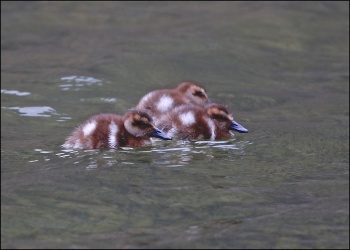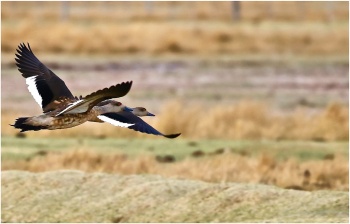- Lophonetta specularioides
Anas specularioides
Identification

Photo © by Dave Clark
Stanley Harbor, Falkland Islands, January 2012
51–61 cm (20-24 in)
- Large
- Short crest produces a specific head shape when seen from the side
- Pale brown
- Flanks have marbled appearance
- Red iris in nominate, orange to yellow in alticola
- Bill dark gray
- Grey legs
- Wings with white speculum, in front of that a black stripe, and in front of that a violet band
Sexes similar but females are darker than the male.
Distribution
South America: found in Peru, Bolivia, Chile, Argentina and the Falkland Islands.
Taxonomy
Subspecies
Lophonetta specularioides has two subspecies:1
- L. s. alticola
- L. s. specularioides
- Central Chile and Argentina to Tierra del Fuego and Falkland Islands.
Habitat

Photo © by Stanley Jones
Yungay, Huascarán National Park, Áncash, Peru, August 2017
Mostly freshwater, lakes and ponds; in the south at sea level but in northern populations in Andean highland wetlands and lakes. Altitudinal migrant in some areas.
Behaviour
Diet
Their main diet consists of insects and their larvae, and molluscs. They also eat some plants and algae.
Breeding
They build their nest in shrubs near to water. The clutch contains 5-7 eggs.
References
- Clements, J. F., T. S. Schulenberg, M. J. Iliff, S. M. Billerman, T. A. Fredericks, B. L. Sullivan, and C. L. Wood. 2019. The eBird/Clements Checklist of Birds of the World: v2019. Downloaded from http://www.birds.cornell.edu/clementschecklist/download/
- Alvaro Jaramillo. 2003. Birds of Chile. Princeton Field Guides. ISBN 0-691-11740-3
- Arthur Grosset
- Handbook of the Birds of the World Alive (retrieved Sept 2017)
Recommended Citation
- BirdForum Opus contributors. (2025) Crested Duck. In: BirdForum, the forum for wild birds and birding. Retrieved 11 May 2025 from https://www.birdforum.net/opus/Crested_Duck
External Links
GSearch checked for 2020 platform.1





